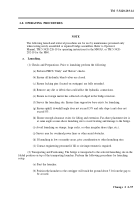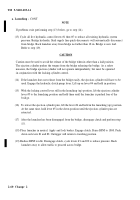TM-5-5420-203-14 - Page 117 of 298
TM 5-5420-203-14
b. Retrieving on a slope
- CONT
(5)
Do not, at any time, continue an operation if any possibility exists of the launcher turning
over or there is evidence of continued tilting, slippage, or other hazardous actions.
WARNING
The bridge and the launcher are very heavy. You can be crushed by the weight. Always
wear your helmet when operating the bridge. If the bridge begins to turn over, DO NOT TRY
TO LEAVE THE VEHICLE. Stay inside and brace your position with your hands and feet.
Do not have fingers or hands in the area of the turret cover. If the bridge tilts to the extent
the launcher turns over, immediately kill the engine, leave the launcher, and remove
injured personnel to a safe distance.
(6) Refer to paragraph 2-8b for procedures to retrieve the bridge.
c. Launching in Wetlands or Marshy Areas.
This Task Covers:
Launching
EQUIPMENT CONDITIONS:
Serviceable
PERSONNEL:
Two
(1) Launching in wetlands or low marshy areas presents many problems. First, consideration
should be given to a second site selection that offers higher, dryer ground.
If this is not
possible, then locate the best possible launching site in the area. The following criteria shall
be met:
(a) A firm, supportive base must exist for the launcher to safely launch the bridge.
(b) A firm, supportive base must exist for both ends of the bridge. If this is not present at
the selected launching site, then site preparation must be done. This may require hauling
in dryer, more supportive dirt, metal grid supports, rock, sand, or any other material that
will improve the site’s ability to handle traffic.
(c) The near shore and far shore touchdown areas must be able to support the continuing
weight of user traffic. The amount of traffic, the weight, and the length of use of the site
must be considered and properly planned for.
(d) When suitable firm, supportive base does not exist on either the near-shore or far-shore
bank, then the banks will require bulkheads. Attempt to locate a new site (if possible)
rather than spend considerable time upgrading this site.
(e) The approach to the bridge should be on the higher ground, when possible. Low areas
should be filled with any available fill that will serve the purpose.
(f) The departure route must be capable of supporting the user traffic. Some fill may be
required.
Change 2 2-67
Back to Top




















